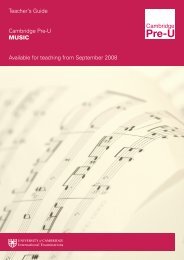Cambridge Pre-U Syllabus - Cambridge International Examinations
Cambridge Pre-U Syllabus - Cambridge International Examinations
Cambridge Pre-U Syllabus - Cambridge International Examinations
You also want an ePaper? Increase the reach of your titles
YUMPU automatically turns print PDFs into web optimized ePapers that Google loves.
24<br />
2. THE ORIGIN AND EVOLUTION OF LIFE<br />
<strong>Cambridge</strong> <strong>Pre</strong>-U Draft<br />
This section deals with the fundamental questions that help us define life – what materials and conditions are<br />
required for life to exist, when did it all get started, how are organisms changing and what drives this<br />
change?<br />
These questions may be put to candidates to stimulate discussion and prompt and direct their own<br />
researches while covering Section 2.<br />
• How and why did life get started?<br />
• Why are some people so sure about the ‘historical fact of evolution’ and why are other people not so<br />
sure?<br />
• Why is water essential for life?<br />
• Where would life be without proteins?<br />
• How independent are mitochondria and chloroplasts?<br />
• What are the mechanisms that drive evolutionary change?<br />
• What is the evidence that evolution explains life in all its richness?<br />
• Why have some organisms become multicellular?<br />
• What exactly defines a species?<br />
• Why is Charles Darwin a controversial figure for some?<br />
• What are the benefits of the classification of organisms?<br />
2.1 The origins of life<br />
Content<br />
Origin of complex organic molecules<br />
Origin of prokaryotic and eukaryotic cells<br />
Advantages of multicellularity<br />
Learning outcomes<br />
Candidates should be able to:<br />
a) outline the Miller-Urey experiment that showed that complex organic molecules (including amino acids)<br />
can form from simple inorganic molecules when subjected to the conditions once thought to have<br />
prevailed on Earth 4 billion years ago when life is thought to have originated<br />
b) describe the evidence for a single origin of life in terms of conservation of key biochemical mechanisms<br />
including the genetic code and the ubiquitin/ proteasome mechanism<br />
c) describe and explain how eukaryotes are thought to have originated about 2.7 billion years ago by<br />
endosymbiosis and the evidence that supports the theory of endosymbiosis<br />
d) discuss the advantages and disadvantages of being multicellular (limited to division of labour and<br />
specialisation, greater control of the internal environment, as against, increased complexity and<br />
coordination issues, vulnerability to trauma)<br />
Practical learning outcomes<br />
Candidates should be able to:<br />
i) use a microscope or photomicrographs to compare small multicellular eukaryotes (e.g. Volvox, rotifers,<br />
tardigrades) with unicellular eukaryotes (e.g. Amoeba, Euglena, ciliates)

















